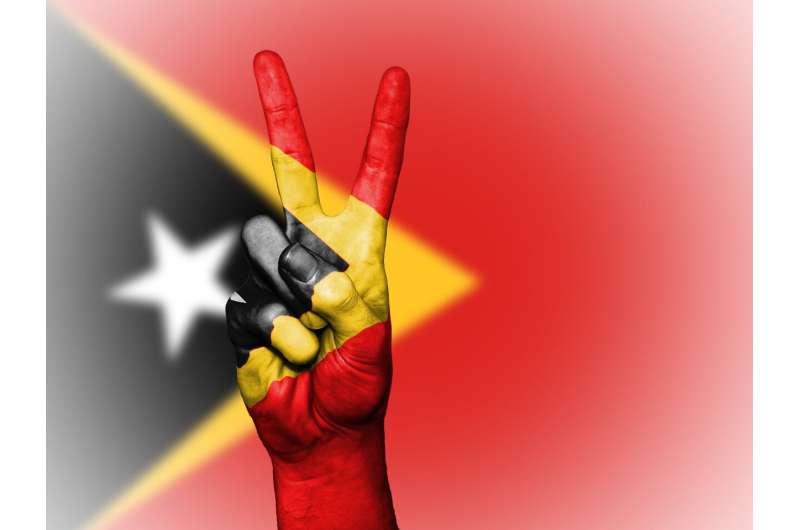Timor-Leste election offers an extraordinary lesson in how to build a stable democracy

After a spirited election campaign, the people of Timor-Leste on May 21. The vote was free, fair and largely uneventful. The results were accepted. This is a remarkable accomplishment for democracy.
With roughly 40% of the and , Xanana ³Ò³Ü²õ³¾Ã£´Ç's National Congress for Timorese Reconstruction (CNRT) looks set to lead a new coalition government. His coalition would replace the current government consisting of the Fretilin party, which developed from the revolutionary movement that fought for independence from Portugal and then against occupation by Indonesia from the 1970s, along with three smaller parties.
This is simply how democracy should work. But in reality, it's a major achievement.
Timor-Leste's story represents towards a parliamentary democracy. Following 400 years of colonial rule by Portugal, East Timor enjoyed brief independence in 1975 before being invaded and brutally occupied by Indonesia. This invasion led to the deaths of approximately .
After Timorese voters endorsed independence in a , Indonesia backed-militias unleashed a terror campaign that killed thousands and destroyed nearly all of the country's infrastructure. International peacekeepers were required to restore order and East Timor was placed under United Nations trusteeship.
Even after in 2002, when the country formally adopted the name Timor-Leste, the country still faced extreme poverty and daunting developmental challenges, all while working to build a new state from the ground up. The rapid departure of UN peacekeepers in 2005 was quickly followed by a .
What began with a domestic military dispute between competing regional factions in early 2006, rapidly spiraled into a large-scale, violent clash between domestic political elites. Violence and instability threatened to collapse democratic governance and even the state itself. The crisis ultimately led to 36 deaths and 150,000 people displaced.
International peacekeepers returned to provide security in the aftermath of the crisis. There were , which ultimately resolved competition between opposing political elites without violence.
Since then, Timor-Leste has consolidated its democracy. Indeed, it is now the only country in south-east Asia rated by the US-based political advocacy group as "".
Surprising success
How did Timor-Leste achieve this surprising success? As I highlight in my recent book, , the people of Timor-Leste beat the odds by drawing on their history of collective resistance. The country was able to establish new institutions capable of turning aspirations of a democratic state into reality.
The decades-long independence struggle brought together diverse interests and groups, from both inside the country and throughout the world. This diverse coalition worked together to promote a shared vision of a future independent and vibrantly democratic Timor-Leste—a vision that stood in stark contrast to life under authoritarian Indonesian rule.
As independence grew near, these groups splintered in the run up to the country's first elections in 2001. Two particularly important factions emerged: Fretilin headed by , and supporters of who now leads the CNRT. From the start, politics were often messy, even divisive, but also provided voters with a real choice among multiple, legitimate political parties. Parties competing for votes became normal.
Even though the 2006 crisis ended up strengthening democracy in the long term, the violence could easily have been a prelude to major civil strife. Instead, it created an enduring distaste among political elites for open, potentially violent confrontation that could easily undermine, or even destroy, democratic governance.
Parliamentary democracy
Constitutionally, Timor-Leste established a where parliament and the prime minister, not the president, are predominant.
Parliamentarians are selected by an electoral system of proportional representation that incentivises compromise and coalition building. Indeed, coalition governments have .
Timor-Leste's experience also highlights the importance of securing support from powerful non-state local justice community leaders, who still enjoy legal authority rooted in local customs and traditions that often predate even Portuguese rule. These individuals had long maintained order locally and were crucial in resisting Indonesian rule. Since independence, they have been essential to both strengthening the local legitimacy of the state and extending its reach far beyond what would otherwise be possible.
Timor-Leste also holds important lessons for international support. It demonstrates the role external aid can play in providing security and support for building a new state. External assistance was generally not compromised by ulterior motives, such as securing mineral resources or concerns about fighting terrorism.
Moreover, the international community generally followed the lead of national leaders, rather than trying to impose unwanted policies or practices. Timor-Leste also shows the importance of not picking winners. The international community was willing to work with whoever was elected without putting a finger on the scale.
To be sure, Timor-Leste still faces , including reducing corruption, fostering sustainable economic development, using the petroleum fund effectively and tackling poverty. Likewise, more needs to be done to fully establish the rule of law and ensure essential rights and freedoms are consistently respected. But these challenges should not obscure Timor-Leste's extraordinary democratic achievement.
Provided by The Conversation
This article is republished from under a Creative Commons license. Read the .![]()



















